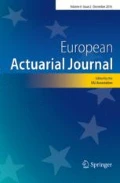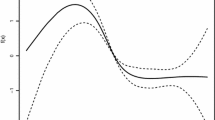Abstract
For actuarial applications we consider the Sparre–Andersen risk model when the interclaim times are Generalized Erlang(n) distributed. Unlike the standard Erlang(n) case, the roots of the generalized Lundberg’s equation with positive real parts can be multiple. This has a significant impact in the formulae for ruin probabilities that have to be found. We start by addressing the problem of solving an integro–differential equation that is satisfied by the survival probability, as well as other probabilities related, and present a method to solve such equation. This is done by considering the roots with positive real parts of the generalized Lundberg’s equation, and then establishing a one-one relation between them and the solutions of the integro–differential equation mentioned above. We first study the cases when all the roots are single and when there are roots with higher multiplicity. Secondly, we show that it is possible to have double roots but no higher multiplicity. Also, we show that the number of double roots depend on the choice of the parameters of the generalized Erlang(n) distribution, with a maximum number depending on n being even or odd. Afterwards, we extend our findings above for the computation of the distribution of the maximum severity of ruin as well as, considering an interest force, to the study the expected discounted future dividends, prior to ruin. Our findings show an alternative and more general method to the one provided by Albrecher et al. (Insur Math Econ 37:324–334, 2005), by considering a general claim amount distribution.

Similar content being viewed by others
References
Albrecher H, Claramunt MM, Mármol M (2005) On the distribution of dividend payments in a Sparre Andersen model with generalized Erlang(\(n\)) interclaim times. Insur Math Econ 37:324–334
Bergel AI, Egídio dos Reis AD (2015) Further developments in the Erlang(\(n\) ) risk model. Scand Actuar J 2015(1):32–48
Bühlman H (1970) Mathematical methods in risk theory. Springer-Verlag, Berlin
Dickson DCM (2005) Insurance risk and ruin. Cambridge University Press, Cambridge
Dickson DCM, Waters HR (2004) Some optimal dividends problems. Astin Bull 34:49–74
Gerber HU, Shiu ESW (2003) Discussion of Y. Cheng and Q. Tang’s Moments of the surplus before ruin and the deficit at ruin. N Am Actuar J 7(3):117–119
Ji L, Zhang C (2012) Analysis of the multiple roots of the Lundberg fundamental equation in the PH(n) risk model. Appl Stoch Models Bus Ind 28(1):73–90
Li S (2008) A note on the maximum severity of ruin in an Erlang(\(n\)) risk process. Bull Swiss Assoc Actuar 2008:167–180
Li S, Dickson DCM (2006) The maximum surplus before ruin in an Erlang(\(n\)) risk process and related problems. Insur Math Econ 38(3):529–539
Li S, Garrido J (2004a) On ruin for the Erlang(\(n\)) risk process. Insur Math Econ 34(3):391–408
Li S, Garrido J (2004b) On a class of renewal risk models with a constant dividend barrier. Insur Math Econ 35(3):691–701
Acknowledgments
The authors gratefully acknowledge financial support from FCT–Fundação para a Ciência e a Tecnologia (BD 67140/2009 and Project CEMAPRE–MULTI/00491 financed by FCT/MEC through national funds and when applicable co-financed by FEDER, under the Partnership Agreement PT2020).
Author information
Authors and Affiliations
Corresponding author
Rights and permissions
About this article
Cite this article
Bergel, A.I., Egídio dos Reis, A.D. Ruin problems in the generalized Erlang(n) risk model. Eur. Actuar. J. 6, 257–275 (2016). https://doi.org/10.1007/s13385-016-0130-2
Received:
Revised:
Accepted:
Published:
Issue Date:
DOI: https://doi.org/10.1007/s13385-016-0130-2




